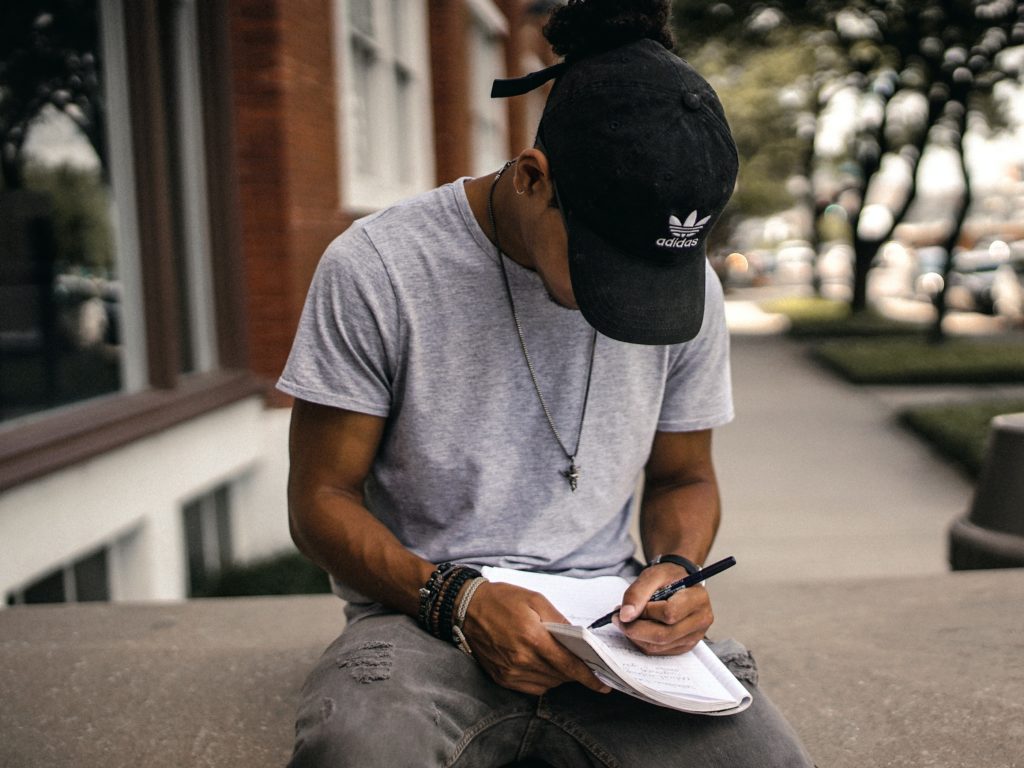AEP Policy Briefing Shares Youth-Centered Policy & Strategies

Young person wearing gray jeans, a gray t-shirt, a black ballcap, a long necklace, bracelets, and a watch. They are facing the camera with their head down, looking at a notebook they’re writing in. They are sitting on a concrete wall. The background is blurry; on the left is a red brick building, and on the right are trees planted along the sidewalk. Image by Brad Neathery.
Last month, Arts Education Partnership hosted an Arts and Juvenile Justice Policy Briefing that gathered policy experts and practitioners from the field to discuss ways to emphasize youth-centered approaches in policymaking for justice-involved youth. A central theme of the conversation was how to help youth “feel good about learning again,” and how this is best accomplished when we listen to their stories of resilience.
Research shows that trauma and stress without resilience or protective factors can negatively impact youth development. Fortunately, safe and supportive school environments that emphasize quality arts education programming provide a vital protective factor that helps build resilience and address the impacts of childhood trauma as students transition throughout life.
This special one-day event featured Maine State Representative Rebecca Millett of the 30th District and Commissioner Peter Forbes of the Massachusetts Department of Youth Services (DYS) and focused on the tools being used successfully by practitioners and policymakers as they work to improve the lives of young people.
Annual state funding to support arts programming was a key consideration for program sustainability. The Massachusetts DYS arts initiative is funded through the legislature education platform and arts-specific funding for teachers. The art teachers work closely with the education staff, the residential managers and community partners to integrate the arts throughout the day. Utilizing a standards-based arts curriculum aligned with Massachusetts Arts Frameworks allows young people’s progress to be tracked, including their transition back into the community and in-classroom engagement programs. Engagement with community-based partners not only brings the arts to youth in the facility, but these partners also supplement the small amount of state funding with grants from philanthropic and grant sources.
Maine State Rep. Millett also expressed the importance of community partnerships through the prevention and transition continuum of youth involved in the justice system. Families First Prevention Services Act is an example of how federal policy can support government and community collaboration to provide trauma-informed, evidence-based interventions and services to prevent the need for foster care placements. Rep. Millett shared that “when youth grow up in unstable environments, they may lack access to the support they need to develop strong executive functioning skills.”
On the other end of the continuum, as youth transition back into the community from juvenile justice settings, Rep. Millett shared how the state has begun mapping assets through Place Matters — a project to implement a community-based continuum of care throughout Maine — to facilitate connecting agencies, programs and services to leverage. The data-sharing tool is accessible to the public to see what currently exists and identifies what is missing in the different regions of Maine.
Asset mapping is one tool used to address this barrier and give communities access to data about their community supports. After speaking with experts in the juvenile justice field, the Arts Education Partnership found that data sharing is a barrier to assessing and providing resources to youth involved in the justice system. One aspect of data The speakers emphasized the importance of collecting data on youth voices to sustain services intended to support their growth.
Research shows that nearly half of children in the United States have experienced at least one adverse childhood experience. Providing access to different arts disciplines can enable youths to make personal choices about their creative expression and tell their stories through artwork. Massachusetts DYS asked youth artist Tasjahnaya to share her talent with our policy briefing audience. With every ask to showcase their work DYS provides these young people with a stipend. Tasjahnaya’s medium for resilience as a formerly justice-involved youth was rap. Encouraging creative expression can offer information on supports needed toward positive youth outcomes that staff may not otherwise know because of lack of data sharing across systems.
Youth can provide valuable insight to the resources necessary to support arts education and are important contributors to policy discussions. By using tools like community partnerships, asset mapping, data sharing and funding, policymakers can empower young people to tell their stories and encourage self-agency over their futures.
* AEP would like to honor Tasjahnaya’s life and contribution to this work. *



